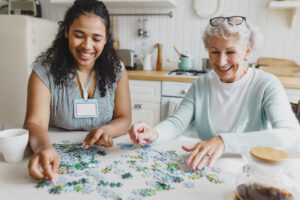As Sherlock Holmes once said to his partner, John Watson, “You see, Watson, but you do not observe.” Even though the quote is borrowed from fiction, there’s an uncanny truth to this statement in real life. In a similar way, active listening is about processing information and utilizing it – not just randomly absorbing facts.
What does this have to do with your aging loved one? Well, if you’re like most people providing home care, you know how easily arguments and misunderstandings can occur. But with these simple listening techniques, you can make communicating with older adults more productive.
Key Active Listening Skills
Try using the techniques below to make your communication with your loved one easier and more productive:
Validate
This is often the first and most critical step in active listening. By normalizing a person’s feelings, you can push past any emotional barriers that might prevent them from speaking honestly. For instance, if you visited your loved one later than expected and they’re upset, you should say something like, “You have every right to be disappointed that I was late.”
Name that Emotion
At times, we all have difficulty putting our feelings into words.[1 “What’s Art Got To Do With It?” https://www.todaysgeriatricmedicine.com/news/ex_082809_03.shtml] By helping your loved one to recognize and name their emotions, you make them more manageable. Another tactic to addressing a tardiness issues is to say, “I know that you’re upset that I didn’t arrive when I said I would.”
Use “I” Statements
You’ve probably heard this one before, but it bears repeating: try to use “I” statements instead of “you” statements. The latter can often seem accusing and defensive, and using “I” statements to share your own feelings can invite your loved one to do the same. For instance, using the example of being late: “I feel upset when you criticize me for not arriving at exactly six o’clock.”
Encourage
To elaborate on a problem or an emotion, your loved one may feel they need implicit “permission” from you to talk about it. This permission includes subtle cues that let them know it’s okay to talk, and that you want to hear what they have to say. Try using brief prompts such as, “Go on,” “How did that make you feel?”, “Then what?”, and “Tell me more.”
Inquire
To get to the heart of a matter, you may need to ask your loved one pointed questions. Examples include, “What would you have done in that situation?” and “Can you think of any alternatives?”
Rephrase
Rephrasing is another key skill in active listening. It doesn’t mean repeating precisely what the speaker just said. Instead, summarize their comments into your own words to show that you’re listening. For example, “You said my being late makes you angry. It seems like this situation causes you a lot of stress.”
Reflect
Reflecting is another form of validating the speaker’s opinion. Like rephrasing, it shows you are listening and processing the information received. “When I’m late, it seems like that throws off your plans for the entire evening.”
Summarize
Summarizing, similar to rephrasing, is a good way to make sure you understand a situation correctly. At the end of a conversation, it’s always good to check that you understand what your loved one is trying to say. Beginning statements can include phrases like, “Let me make sure I have this right,” or “So, what you’re saying is . . .”
Allow for Silence
We’re often taught that silence in a conversation is bad and to avoid it at any cost. But by allowing for silence during active listening, you open up a space for others to talk and think[2. “The Effective Use Of Silence,” December 11, 2009, https://www.psychologytoday.com/blog/happiness-in-world/200912/the-effective-use-silence]. Don’t be so quick to jump in with what you think the other person will say or force your own thoughts on them too soon. Silence in conversation can be one of the most important listening tactics that many caregivers forget.
Redirect
This is often a big part of actively listening to older adults, who sometimes veer off topic easily. By bringing their attention back to the matter at hand, you help them focus on what’s important, such as the subject being discussed, or the problem to be resolved. Case in point: “I know you didn’t enjoy the dinner you had tonight, but let’s finish talking about my being late because I know that’s really bothering you.”
Start Communicating with Older Adults in a Whole New Way
Regularly using active listening can help you relate to your loved one in a whole new way. And it isn’t just a great method for communicating with older adults – it works for almost all age groups. Who knows? By practicing this skill, you may end up having better communication with everyone you meet!
If you’re unsure how to best help an aging loved one, the trained and compassionate staff at the Institute on Aging is here to help you make that decision and gain the best in at-home care for older adults. Contact us to find out more.







